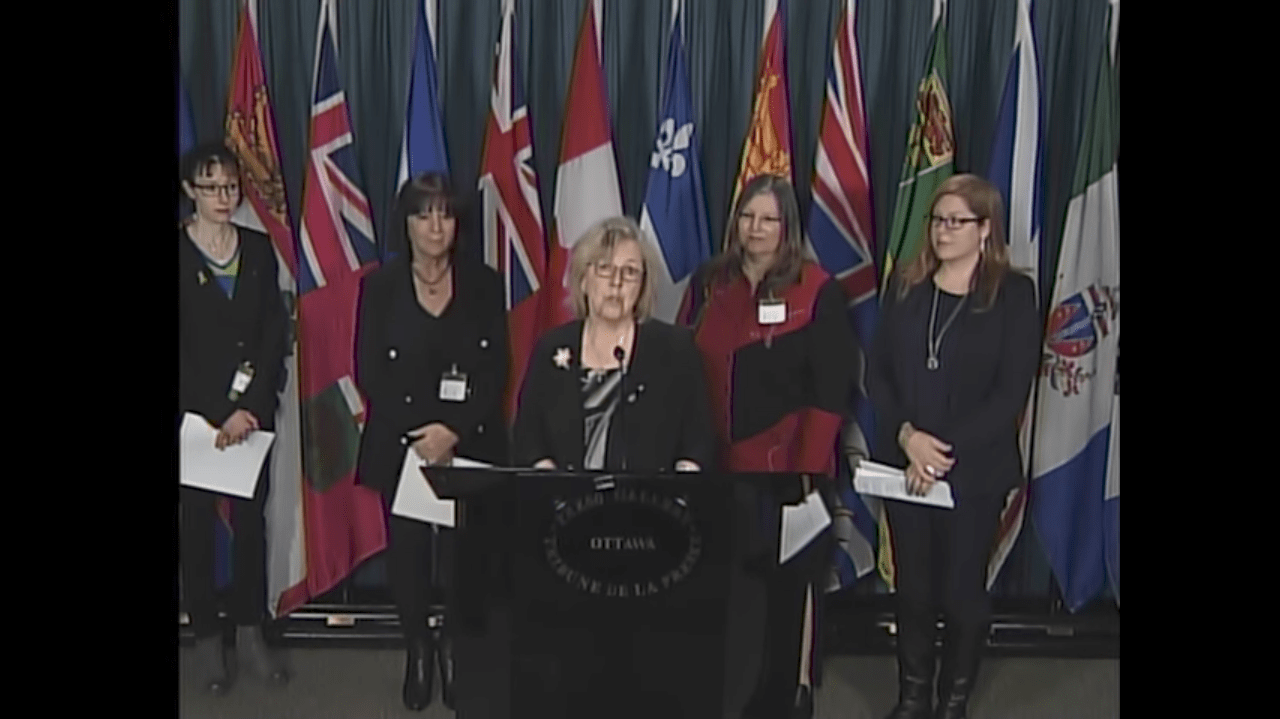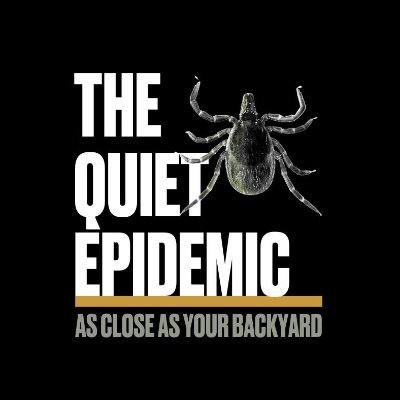13
Apr
2017
Responses to the draft federal framework

The release of the draft federal framework by the Public Health Agency of Canada has led to great disappointment in the Lyme disease community in Canada and Quebec. This framework does not meet the mandate of Bill C-442 and did not take into account the divergence of opinions presented at the May 2016 conference.
Green Party leader Elizabeth May held a press conference on the subject with several of Canada’s disease experts, and her party issued a press release: Researchers, doctors and patients need to be more involved in the design of the preliminary Lyme disease framework, say committed leaders.
You can watch the press conference below, and you’ll also find the official response to the federal provoise framework submitted by the AQML during the consultation period.
AQML’s official response to the Public Health Agency of Canada‘s Consultation on the Interim Federal Framework for Lyme Disease, written by Vice-President Annie Roussy.
“On behalf of all the members of the Association québécoise de la maladie de Lyme (AQML), we would like to offer our comments on the draft federal framework for Lyme disease.
The aim of our association is to raise awareness of Lyme disease and its co-infections, and to work towards obtaining from medical and governmental authorities, both public and private, adequate prevention, screening, diagnosis, treatment and support services for all stages and aspects of these diseases. In this sense, we consider the draft federal framework for Lyme disease in Canada to be inadequate. It does not respond to the challenges of recognizing Lyme disease and rapidly establishing its diagnosis and treatment, as defined by the Federal Framework for Lyme Disease Act. On the contrary, in too many respects, it maintains the status quo. This is not in the public interest. This draft may go some way towards ensuring that Canadians avoid contracting this disease, but it does not adequately support those already affected.
As you state in this draft: “The conference to develop a federal Lyme disease framework, held in May 2016, brought together Lyme disease patients, representatives from federal, provincial and territorial health ministries, patient groups, researchers and health care providers to share their perspectives, the latest available scientific evidence, and make recommendations on the way forward.” You use the lie when you say: “The comments provided by all representatives have been taken into account in the development of this framework…”. The main common messages of the public forum are clear, and they are the same ones that our members mention to us:
- Canada’s healthcare system has failed Lyme disease patients.
- The disease has caused a great deal of medical, mental and financial suffering.
- The medical community in general is unfamiliar with Lyme disease and ticks.
- Misdiagnosis is common. The symptoms of Lyme disease overlap with those of other complex chronic illnesses, such as fibromyalgia, chronic fatigue and depression.
- In the case of Lyme disease, misdiagnosis or inappropriate or inadequate treatment has destroyed lives, families and careers.
- Many patients are frustrated by having to consult several specialists instead of benefiting from a holistic approach to treating this chronic disease.
- Many patients don’t feel that the medical community respects and listens to them, and Lyme disease is stigmatized.
- Many patients have to leave the country for treatment, which is very costly for them.
- Early detection is essential – the burden of the disease increases without prompt and adequate treatment.
- Current screening tests are inadequate, producing both false-positive and false-negative results.
- Lyme disease is under-reported – many more Canadians could be suffering from it.
- Cases of co-infection and multiple strains must be recognized and tested.
- The Canadian public and the medical community need to know more about Lyme disease prevention and symptoms.
The direction of the draft framework in no way reflects the recommendations of these participants. You need only refer to your own Summary Report of the Conference to Develop a Federal Framework for Lyme Disease to see the overwhelming evidence.
Section 3 of the Federal Framework for Lyme Disease Act is very clear: “Not later than twelve months after the day on which this Act comes into force, the Minister shall convene a conference with provincial and territorial ministers and stakeholders, including representatives of the medical community and patient groups, for the purpose of developing a comprehensive federal framework…”.
Even if you state in the conference summary report that: “The opinions and views expressed at this conference are those of the presenters and participants, and do not necessarily reflect the opinions and views of the Government of Canada”, you cannot deviate from the Federal Framework for Lyme Disease Act.
Minister Dr. Philpott says that “the information, ideas, comments and opinions from the conference will all be taken into consideration during the development of the federal Lyme disease framework. The results of the conference will ultimately help protect the health and well-being of all Canadians.
Dr. Gregory Taylor, Chief Public Health Officer, Public Health Agency of Canada added that the conference is one step in a much broader consultation process, which is essential to the development of the framework. That consultations to gather input were held prior to the conference, and as the development of the framework continues, further consultations will be held. That stories of personal experience will shape and influence discussions at the conference. He noted that the purpose of the conference is to obtain guidance and advice.
Dr. Daniel Gregson, past president of the Association for Medical Microbiology and Infectious Disease (AMMI) Canada, noted that the conference brings together patients, delegates and experts who have come to help the Public Health Agency of Canada develop a federal framework for Lyme disease. He noted that this is a very important meeting to find common ground. For members of the Association for Medical Microbiology and Infectious Disease (AMMI) Canada, the conference is an important opportunity to develop an evidence-based, scientific framework for tackling this important health issue.
Ms. Elizabeth May, MP, Green Party of Canada, also indicated that the goal of the legislation is to develop a patient-centered federal framework for Lyme disease. That the status quo must end. That she had faith in the process of developing the framework and that it would remain transparent and inclusive.
Now that you say “We will take into account the comments received from this consultation to guide the final federal framework on Lyme disease”. We ask you to do your original duty and develop this draft federal framework “as it should be, in the respect and compliance expected of the Lyme Disease Federal Framework Act. This time, to really take into consideration all the comments you receive.
As currently drafted, this document seems to reflect the fruits of unilateral and exclusive reflection by members of the Public Health Agency of Canada, without any consideration of previous consultations.
In addition, we remind you that Dr. Gregory Taylor, Chief Public Health Officer, Public Health Agency of Canada has observed that the Public Health Agency of Canada’s goal is also to make things better for people. In his view, if the Agency isn’t helping Canadians, if it isn’t making a difference in their lives, then it isn’t doing its job. We don’t see this draft as making a difference in the lives of people who have or will have Lyme disease.
To this end, we ask you to refer appropriately to the summary of the Conference to develop a federal Lyme disease framework, as stipulated in section 3 of the Federal Lyme Disease Framework Act:
- the establishment of a national medical surveillance program that uses the data collected by the Agency to adequately monitor changes in incidence rates and economic costs related to Lyme disease;
- The establishment of guidelines for the prevention, identification, treatment, and management of Lyme disease, and the sharing of best practices at the national level.
- The creation and distribution of standardized educational materials on Lyme disease for healthcare providers in Canada, aimed at raising awareness of the disease at the national level and improving its prevention, identification, treatment, and management.
The central focus of the framework is the establishment of guidelines for the identification and treatment of Lyme disease. If you truly want to support Canadians who are already affected by this disease, it won’t be with a framework written in its current form.
We remind you that the Federal Framework on Lyme Disease Act was built on the following principles: “That recent research highlights the resistance of Borrelia spirochetes to antibiotic treatments following the guidelines in use in Canada (Embers et al., 2012) and indicates that current serology does not adequately account for the diversity of Borrelia bacteria present in Canada, and that the general understanding of Lyme disease, as well as treatment practices, are no longer sufficient or adequate in light of new data on how the disease functions (Ogden et al., 2011); that the guidelines currently in force in Canada, which are based on those of the United States, are so restrictive that they severely hinder the diagnosis of acute Lyme disease and deny the existence of chronic infection, thereby neglecting individuals suffering from a curable disease.”
The Lyme disease policy in Canada must be developed domestically and not be an imported policy. How can you continue to approve and encourage the use of the Lyme disease treatment guidelines developed by the Infectious Diseases Society of America (IDSA)? Yet, in your introduction, you state: “To guide the development of this framework, the Public Health Agency of Canada, on behalf of the Minister of Health, held a conference in May 2016. More than 500 participants attended, either in person or via an online interface. Lyme disease patients, their families, and other stakeholders shared their experiences with the disease. Additionally, subject matter experts provided information on current knowledge and research related to the treatment, prevention, diagnosis, and management of Lyme disease.”
However, when we turn to the conference and its summary, the experts who presented noted that clinical trials support the idea that repeated antibiotic treatment is beneficial (page 9). Moreover, representatives of the medical community stated that physicians are constrained by the current guidelines and often lack knowledge about the disease, that the guidelines are not flexible enough, are more effective in the early stages of the disease but not in the later stages, and that the two-tiered testing under the guidelines is considered an effective approach (page 14). Furthermore, through the legal consultation process, the majority of those affected by this disease have reported the inefficiency of these guidelines to you.
Stop clinging to terms like “evidence-based” and “best practices,” which you repeatedly use. Establish a federal framework that takes into account the recommendations and ideas from point 8 (pages 17 to 28) of the conference summary. Do not narrow the scope deliberately and unilaterally to support a stance that does not align with the Federal Framework on Lyme Disease Act.
Ensure that this framework actively promotes:
- That ticks can be present throughout the entire Canadian territory, even if they have not been recorded in a surveillance program.
- The diagnosis of Lyme disease should be made solely on a clinical basis, without consideration of any potential exposure history to ticks.
- That physicians be authorized to prescribe long-term antibiotic treatment and, as a result, be protected from sanctions by their licensing bodies.
In doing so, you will respect the *Federal Framework on Lyme Disease Act* and promote better health for current and future Canadians affected by this serious disease—Lyme disease.



